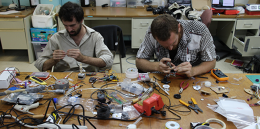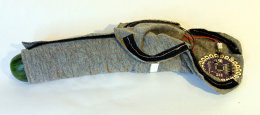A WORLD OF OPEN SOURCE SEX TOYS, BUILT BY THREE GEORGIA TECH STUDENTS
HOW A “DIGITAL CONDOM” CALLED THE ELECTRIC EEL IS KICKING OFF A MOVEMENT.
The Stitchfest hackathon at UPenn didn’t know what was coming when Andrew Quitmeyerand Firaz Peer built an Arduino-powered genital shocker for their DIY hacking contest. This was no stunt: Quitmeyer intends for the DIY sex toy to be one of an open source suite when he opens Comingle next August—what he hopes will be the “Adafruit of sex toys.”
The “Electric Eel” prototype uses multiple conductors to zap the wearer’s shaft with low-voltage electricity—which is physically stimulating and definitely won’t burn, Quitmeyer insists, who bravely donned the prototype in front of hackathon judges. Though none of them would try out the prototype, says Peer, one licked an equivalent electrode-lined sheet of fabric…and found it pleasurably shocking.
Any other “new sex toy” innovation might stop there, but Quitmeyer and Peer built the Electric Eel with an Arduino microcontroller. Instead of writing bland programs to alternate the Eel’s zapping frequency, Quitmeyer wants to include biometric sensors that’ll allow a range of inputs to the sex toy’s code. Below is Quitmeyer’s (SFW) demonstration of a crude biosensor hooked to the Eel that zaps with each intake of breath.
 But by opening the Comingle repository with fellow PhD candidate Paul Clifton, Quitmeyer doesn’t just want to create the next generation of sex toys—he wants to inspire folks to create and iterate their own.
But by opening the Comingle repository with fellow PhD candidate Paul Clifton, Quitmeyer doesn’t just want to create the next generation of sex toys—he wants to inspire folks to create and iterate their own.
And it gets weirder still, when you learn this innovation story began with ants in a Panama jungle.
Quitmeyer began delving into robotics four years ago while taking classes for a Digital Media Master’s at Georgia Tech. A self-described polymath, Quitmeyer holds undergrad degrees in film and industrial engineering. In a sense, his Master’s experiments disrupted societal assumptions, often by grossing out or messing with folks on the street. His first piece, Ducks Feeding people, had an Arduino-powered giant duck head spew candy rewards to people feeding regular ducks in the park.
Quitmeyer got another request: A group of scientists at the Smithsonian Tropical Research Institute needed a dynamic computer program to help them track ants in the jungles of Panama. He flew down to view their working conditions.
The scientists were using lab-developed procedures inadequate for the field, where ants crawl up 3-D structures and blend in with their surroundings. Quitmeyer built a light sensor sensitive enough to tell when the ants’ shiny bodies reflected less light than the flat bark.
Quitmeyer started following the scientists around as they studied animals in their habitats. Inspired by their tasks and inadequate tools, Quitmeyer started building his own—a small fleet of specialized robots. One example, a simulated woodpecker, increasingly freaked out ant colonies as the robopecker pecked at different biologically accurate rhythms. Another was a stereo-smelling device that mimicked insects’ dual antennas that allow them to smell directionally.
 Stereo-smelling deviceQuitmeyer was simulating nature with cheap robo parts from a remote workbench. As he began holding workshops to teach the scientists how to build their own animal-interacting bots, he fell in love with the roaming experimental nature of these scientists’ lives. He upped to a PhD in Digital Naturalism at Georgia Tech and started scrounging personal money to fly back to Panama to continue his animal and robotic studies. Meanwhile, he was having a ton of fun using his computer science background to teach scientists how to create dynamic versions of static experiments with bots they could make themselves.
Stereo-smelling deviceQuitmeyer was simulating nature with cheap robo parts from a remote workbench. As he began holding workshops to teach the scientists how to build their own animal-interacting bots, he fell in love with the roaming experimental nature of these scientists’ lives. He upped to a PhD in Digital Naturalism at Georgia Tech and started scrounging personal money to fly back to Panama to continue his animal and robotic studies. Meanwhile, he was having a ton of fun using his computer science background to teach scientists how to create dynamic versions of static experiments with bots they could make themselves.
And then, during one of his impromptu robot workshops last year, someone asked Quitmeyer if he could use his robot know-how to build a vibrator.
It’s no surprise that Quitmeyer jumped at the challenge. His Digital Media studies focused on playful subversion of societal expectations—like his “pee to check in” primitivist revival critique of Foursquare, “Mark Your Territory.”
“The vibrator was a really interesting design aspect, especially because I was in this really limited environment, trying to MacGyver a dildo like this,” says Quitmeyer. “Using a simple workshop under unusual workshop conditions revealed to me not only the demand but also how easy it would be for someone to create and modify their own sex toys.”
 After returning to Georgia Tech, Quitmeyer sat down with his program peer Clifton to think seriously about an idea they’d thrown around. In August 2013, they wrote the charter and mission statement for Comingle. Clifton began looking around sex toy review blogs and local shops—and found that sex toys haven’t innovated in decades. You’re lucky to get a remote. The high-end toys look more like industrial art pieces, says Clifton, so they decided to push back from the tech side instead.
After returning to Georgia Tech, Quitmeyer sat down with his program peer Clifton to think seriously about an idea they’d thrown around. In August 2013, they wrote the charter and mission statement for Comingle. Clifton began looking around sex toy review blogs and local shops—and found that sex toys haven’t innovated in decades. You’re lucky to get a remote. The high-end toys look more like industrial art pieces, says Clifton, so they decided to push back from the tech side instead.
But it was the playful scientific experiments with his fleet of bots that Quitmeyer credits with thinking digitally for new, dynamic, hackable sex toys. Quitmeyer found that some scientists’ experiments were being focused around their older, inflexible tech. With Quitmeyer’s bots, they broke the cycle of technological determinism.
“There was cross fertilization with my animal research,” says Quitmeyer. “They’re both about interacting with senses of animals that we usually ignore in most interaction design. We weren’t looking at screens or mice or keyboards ’cause animals can’t use those standard, very visual approaches to interacting with computers.”
The fruits of that labor: biometrics. Like the primitive breath-controlled mechanic in the Electric Eel prototype, Quitmeyer and Clifton see incredible opportunities by linking sex toys to pulse, light, or motion sensors to stimulating servos or electrodes.
The Electric Eel may not have impressed the judges, but passersby were certainly entertained—and incentivizing condom use is a novel approach to the Bill and Melinda Gates Foundation’s condom challenge to make condom use more enjoyable. While Firaz, Quitmeyer, and Clifton haven’t discussed where the Eel will fit in the Comingle family of devices, it shows the radical thinking that these design and interface junkies are bringing to an industry desperate to be brought into the age of the Internet of Things.
 Quitmeyer and Clifton plan to unleash Comingle in August 2014 at the earliest with a suite of three to four blueprints. Because of the taboo surrounding sex toys, the pair have have done their testing in private, but that won’t be the biggest shock to their social circles.
Quitmeyer and Clifton plan to unleash Comingle in August 2014 at the earliest with a suite of three to four blueprints. Because of the taboo surrounding sex toys, the pair have have done their testing in private, but that won’t be the biggest shock to their social circles.
“What will surprise people more will be me coming out as a businessman instead of a tech weirdo,” says Quitmeyer.
He’ll still be a bit of a tech weirdo—after all, most businesses don’t give away their device blueprints for free. Quitmeyer and Clifton want Comingle to be a nexus for sharing iterations and improvements with others a la Adafruit’s microcontroller enthusiast community. They figure to make money directly selling device components that are difficult to find elsewhere.
By hosting this conversation and community, Quitmeyer hopes to loosen up society.Tupperware party-style sex toy exchanges are already commonplace on college campuses—Quitmeyer hopes to raise the bar with sex toy hackathons. But at its core, the pair want the DIY aspect to empower users.
“It’s important that we be supportive of people who want to build these things themselves—especially regarding sexuality,” says Clifton. “If we take sex toys from a women’s perspective, and if sex toys are a way for women to take control of their bodies, then the next step is creating their own devices instead of just going out and purchasing them.”
Sex tech has already broadsided the tech world with the annual Arse Elektronika, which Quitmeyer and Clifton caught in San Francisco last October. A few attendees who made their own sex toys sparked the Comingle boys’ imaginations. Likewise, they were inspired by venerable device hacker Micah Elizabeth Scott’s work making a Wi-Fi-enabled feedback vibrator in Nov 2012. Sex toys and sexuality get people interested in tech who wouldn’t otherwise be intrigued by Make magazine or RC copters, says Clifton. They’re hoping Comingle can reach out to and engage this lost flock who might just need a little zap to get them into the tech fold.
Comingle still has kinks to work out before unleashing the first open source sex toy haven in late summer 2014. When it comes to such sensitive applications, perfecting the installation of gizmos in silicone and getting the molds to look just right will require the utmost care. But inspired acolytes can take the first step toward the future of sex toys by following Comingle on Twitter and signing up for their mailing list.
For now, Comingle is a plan and a placeholder site—but inspired donators can take the first step toward the future of sex toys by endorsing the Electric Eel on Indiegogo
